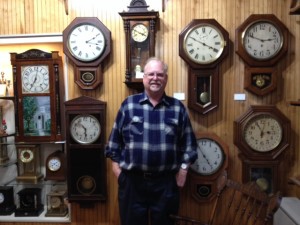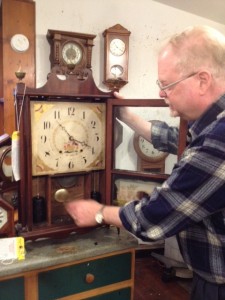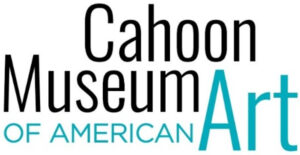
NANCY RUBIN STUART PHOTOS
John Anderson surrounded by a wall of clocks.
Time is of the essence. Especially for John Anderson, whose wall of antique clocks tick steadily along in his Dennis shop, The Village Peddlar, on Route 6A. The shop is where he restores and repairs old timepieces. An antique clock expert and repairer, Anderson said he rarely gets bored even though he been working on clocks for 45 years.
“Every day is different because each clock is unique. I rarely have to work on the same thing twice. Sometimes the mechanism needs to be cleaned or repaired or restored. The wood casings can also be different, for some need repair or refinishing,” he said.
As a young man, Anderson never intended to become a clock expert.

John Anderson works on an early 19th century time piece.
In 1971 while Anderson worked as an electrician in New York’s Duchess County, an economic slowdown depressed the building industry. Then in his early 20s, he owned a house with a mortgage and was married to a woman with three young children. To supplement his flagging income, he spent weekends working as an assistant at an auction house; then at two other auction houses where he learned about antiques. Occasionally, an old clock was auctioned off but Anderson gave it little thought. “The one thing I noticed was that buyers paid more for a clock if it was running,” he recalled.
One day, Anderson’s friend Bo Sullivan of Forge Antiques and Forge Auctions of Bedford Hills, New York mentioned he and another dealer, Bob Albert of nearby Peekskill, had purchased a lot of 500 old clocks from a New Orleans dealer. “Twenty clocks arrived in each crate. When we opened them we never knew what we’d find. It was like Christmas,” Anderson said.
Sullivan and Albert knew that the seven large clock manufacturers in Connecticut—among them Seth Thomas, Sessions and Ansonia—had exported thousands of clocks in the 1880s to Europe and Asia. In 1971 when Sullivan and Albert bought their first lot, the labels and identifications on the clocks were missing so they were unable to document the manufacturers. In 1972, after a successful marketing campaign—$32 each for antique clocks in running condition and $28 for those that weren’t—they traced their origins. Modeled on American clocks, most were produced by Japanese manufacturers nearly a century earlier.
“At first the Japanese imported American clock parts and movements and made their own casing, but by the early 20th century they were producing their own clocks and exporting them throughout Asia,” Anderson explained. Having successfully sold that first lot, his friends Sullivan and Albert began buying other lots of old clocks which they resold to auction houses and other antique dealers. Anderson, meanwhile, had learned how to clean and make minor repairs on the clocks to ensure they worked. One day while unpacking a crate, he told Sullivan that their sales could increase if the clocks were sold through mass-marketing and mail orders. The auctioneer applauded the idea. Before long the two of them teamed up with auctioneer Simon Wittner, whose family owned a Madison Avenue advertising agency. Their new company was called the Pony Express System.
Company ads appeared in the Wall Street Journal, Yankee Magazine, Sunset and the Smithsonian Magazine illustrated with pictures of antique clock and headlined “One of America’s Last Great Antique Buys.” Within a year, the Pony Express System was selling 120 clocks a day and by the second year, 175 clocks daily. That led the partners to purchase clocks wherever they could—from the United States, Europe, and especially Asia. By then Anderson could make complex repairs on clocks and was supervising 40 people to repair or restore them in an assembly line. Prices ranged from $139-$150 for the three most popular styles: two types of schoolhouse clock and the English style double-rolling pin wheel clock.
Sales boomed through the 1970s during which the company sold approximately 135,000 old clocks. But by 1979, the quality of the imported clocks had declined, making restoration more difficult. Ultimately Anderson and his partners closed the business.
That same year Anderson, his wife and children moved to Dennis where he opened his first clock shop west of his current location. Today a faded sign identifies his second shop in the Theater Marketplace plaza. When asked why he doesn’t have a more prominent sign, Anderson smiles. “I’ve got plenty of business. People know about me and can find me if they want to,” he said.
With a backlog of 35 or 40 clocks waiting for restoration or repair, time doesn’t lie heavily on Anderson’s hands.
By NANCY RUBIN STUART
























